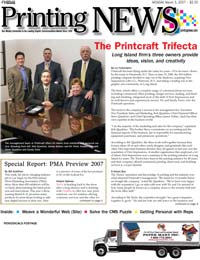|
  Mar. 5, 2007—Today, no company can survive without an online presence. In the beginning of the Web era, it was enough to have a site where customers and potential customers could go simply to see your equipment list and obtain contact information. Now, clients want to estimate, submit, and track jobs, and access real-time information 24 hours a day, seven days a week. Mar. 5, 2007—Today, no company can survive without an online presence. In the beginning of the Web era, it was enough to have a site where customers and potential customers could go simply to see your equipment list and obtain contact information. Now, clients want to estimate, submit, and track jobs, and access real-time information 24 hours a day, seven days a week.
In the Age of the Internet, your portal is often the first, and most frequent, point of contact with clients. It is an increasingly crucial part of the business landscape to have a well-designed, easy-to-use, feature-rich site—and while that would seem obvious, it is surprising how difficult it can be to fulfill all three requirements.
Ask the Right Questions
Before a redesign can begin, you need to identify the goals and objectives for your site, as well as who the intended audience is. Will it be a portal primarily for existing clients? Will you use it as a marketing tool to attract new customers? Does your audience demand the ability to order and pay online, or do they just want a place where they can get advance information? Do they want estimates via the Web, but order through a live sales representative?
These questions are only the tip of the iceberg. The discovery phase is the most rushed part of Web site development, according to Angela Burns, business development director, and Damian Engel, multimedia designer, One Solution Studio, a Web site design and development studio based in Tampa, Fla. “Clients tend to want to rush into the design. This causes changes during development to the site structure, budget, and deadline,” noted Mr. Engel.
VistaPrint, a Web-based print firm, took that advice to heart. Before overhauling its site, the management team decided what the site needed to be before ever writing a line of code or designing a template. “We had a few areas that we wanted to address,” said Melissa Crowe, vice president of marketing services, VistaPrint. “First, there were portions of the site that were not as easy to use as we would have liked, so increasing the functionality in certain areas was important.
“Another sticking point was that with our old Web site, customers weren’t being made aware of the complete line of products we offered. Finally, the experience on the site sometimes wasn’t seamless all the way through, and we wanted to make sure that for our customers, browsing to purchasing flowed well and was simple,” she added.
The Marsid-M&M Group, Carle Place, N.Y., had a similar experience, knowing it needed to fit the site to its clients’ needs. “The single most important deciding factor in redesigning our site was and is always the customer experience. This question cannot be answered by mention of one specific feature—we needed to create new tools that allow clients to work with us in a more efficient manner,” said Cliff Krauter, director of marketing and IT.
When it comes to Web design, the two biggest factors are form and function. Many sites are willing to sacrifice one for the other, but that does not have to be the case. “Having a Web site with a professional design to visually attract a potential client at first glance is very important,” said Mr. Engel. “We all tend to judge appearances first and foremost. While appearances will get your foot in the door, another important factor of a good Web site is the ability to present information, processes, and sales through more than one avenue. Easy accessibility to print specs, prices, options, templates, types, sample requests, quote forms, and quote generators will provide potential and current clients the tools and information they require when formulating project information and additional questions.”
Ms. Crowe agreed, “More often than not, when it comes to Web sites, perception is reality. If something looks and feels simple, then for the customer, it usually is. When the site feels cluttered and difficult to use, customers get frustrated and find things difficult.”
“I wouldn’t call a Web site that allows you to do everything yourself full service—fully featured would be a better description. Service is about people, and truly excellent commercial printing is all about service. So I think it’s essential to back a fully featured Web site with personal service,” said Mr. Krauter.
One area that gets overlooked often is the human element. “Printing is about people and relationships in my opinion. No matter what method of conversion you’re using, your clients deserve a high level of service. Simply creating a Web site, regardless if it allows the client to do everything for themselves, that alone is not the answer to a more meaningful level of success,” Mr. Krauter continued.
Part of ensuring that users feel like they are already a client, and not just another hit to a Web site, is continuously asking them for feedback, getting their opinions on what is working and what still needs improvement.
“Always measure the success and functionality of the site,” said Ms. Crowe. “It’s important to have your finger on the pulse of how customers are using and reacting to the functions and various pages on your site. Knowing what they want, how they want it, and how you can best deliver it to them is what will ultimately make you a success.”
Mr. Krauter agreed, noting that his company has taken a proactive approach on soliciting feedback. “We receive feedback regarding the Web site every day, usually from new clients submitting estimate requests. It’s pretty nice when it happens, and we inform everyone involved in development. Many tools have been added from such feedback. In addition, we regularly send feedback surveys to our clients requesting suggestions on how to improve our site and services—who better to ask than your clients and visitors?”
There are many organizations out there that offer services to help you get the most out of your site, while others opt to bring the work in-house. Whatever option you decide to go with, spend time up front talking to customers and potential customers about what they want to see in terms of both features and the look and feel of the site. It will save you time on the back end, and will ensure that you have a site meant to dazzle and impress, as well as provide practical information.
Take the Right Steps
Sidebar By Toni McQuilken
When it comes to Web design, there are a few steps you should take to make the process easier on everyone involved. One Solution Studio offers this checklist to get you started.
- Identify goals and objectives. Are you looking to attract new customers, improve customer service, improve external and/or internal communication, reduce costs, or build e-commerce?
- Address the intended audience. Your Web site should provide specific information to the target audience that will be most apt to perform a profitable action, whether it be placing an order, signing up for your newsletter, identifying with your brand, or just bookmarking your site for future use.
- Conduct a competitive analysis. Your Web site needs to stand out if you are going to succeed online. Perform a comprehensive review of the design, navigation, content, and features of your competitors’ sites.
- Evaluate and select specific site features. Most companies are looking for specific attributes in their site. Choose and incorporate these functions and more: e-mail newsletter, e-commerce, online display, paid search, blogs, and whatever else you may need.
- Measure your site’s success. How do you envision online success? Measure it through specific metrics including: number of new clients, sales goals, number of newsletter subscribers, time it took to develop the site, ease of maintenance, total cost, and response from visitors.
|


